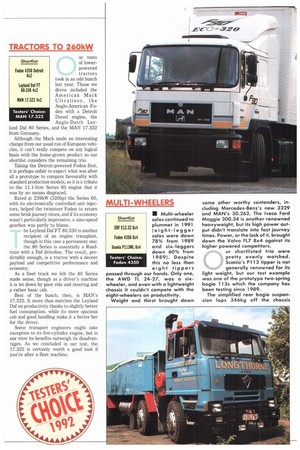Shortlist
Page 36

Page 37

If you've noticed an error in this article please click here to report it so we can fix it.
ERF E12,32 8x4 Foden 4350 8x4 Scania P113114L 8x4
Testers Choice: Foden 4350
• Multi-wheeler sales continued to plummet in 1991 (eight-legger sales were down 78% from 1989 and six-leggers down 60% from 1989). Despite this no less than eight tippers passed through our hands. Only one, the AWD TL 24-27, was a sixwheeler, and even with a lightweight chassis it couldn't compete with the eight-wheelers on productivity.
Weight and thirst brought down some other worthy contenders, including Mercedes-Benz's new 3229 and MAN's 30.262. The lveco Ford Maggie 300.34 is another renowned heavyweight, but its high power output didn't translate into fast journey times. Power, or the lack of it, brought down the Volvo FL7 8x4 against its higher powered competitors.
ur shortlisted trio were pretty evenly matched. Scania's P113 tipper is not generally renowned for its light weight, but our test example was one of the prototype two-spring bogie 113s which the company has been testing since 1989.
The simplified rear bogie suspension lops 346kg off the chassis weight; combined with good fuel consumption and performance figures this gave the Scania a good productivity rating.
The other two, ERF's E12.32 and arch-rival Foden's 4350, had identical Perkins Eagle Tx 325 engines, despite the Foden's 350 tag, but the similarities ended there. Drive was transmitted via a 12-speed Eaton Twin Splitter box in the ERF, while the Rockwell single-reduction double-drive axles were mounted on Hendrickson-Norde rubber suspension. Its torquey 12.17litre Perkins engine helped to give it plenty of driver appeal and its price tag should keep the gaffer smiling.
ongthorne of Hebden's Foden used a 13-speed Eaton constant mesh box, driving an Eaton tan dem bogie. Pete rbilt Air-Trac suspension from Foden's American parent Paccar provided "roadfriendly" suspension for the Eaton bogie, earning it extra Brownie points. like the ERF, the Foden uses a rot-resistant GRP cab.
At 8.49 tonnes, the chassis-cab was the lightest eight-logger tested during the year, giving a full 22 tonnes of body/payload. The Foden flew round our tipper route at on average 67.7km/h (42.1mph) which put it among the quickest we have tested and made it the fastest in 1991. With fuel consumption of 33.751it/100km (8.37mpg) overall its productivity earnings factor was good too.
Even with the Air-Trac suspension it undercut the Scania on price by a considerable margin and the basic chassis is cheaper than its Sandbach rival. So, by the tightest of margins, the Foden is our Testers' Choice for 1991.
Leyland Daf's powerful FA60.210, complete with optional factory-fitted cab fairings and body valances, delivered a formidable performance to prove that a fast truck isn't necessarily a thirsty one.
As well as being the fastest 17-tormer tested to date it was also the most economical, although it is impossible to say exactly how it might have faired without its aerodynamic cladding.
It's 21.1lit/100km (13.4mpg) was 3.0% better than our previous best — an Iveco Ford Cargo tested back in November 1989 — and nearly 4.0% ahead of MAN's 17.192. Without resorting to the use of optional aluminium the 60-Series achieved a fairly low kerbweight, a smidgin under that of the eventual winner's, and helped it earn top marks for productivity.
However, its spares are a little more expensive and it carries the burden of a high retail price, all of which detracted from its fleet appeal. All in all, we considered it represented a little less value for money than the other two 17-tonners in the frame.
Despite the FA60.210's storming performance, MAN's 17.192F middleweight addition to its ECO range took the overall honours. It was some consolation for this Munich-made rigid which was eliminated from last year's 17-tonne Euro Economy Run for driver error.
ontrary to its previous reputation for being thirsty and heavy, our tester thought this F90 newcomer had made some real improve ments. We thought its sombre cab was well engineered with some neat touches, like the leather kick patches on the door's lower edges and the locker on the engine cover.
Apart from a somewhat notchy ZF gearbox the 17.192F is a very easy truck to drive. Thanks to its bigger, torquier M90 EC() engine the MAN produced quite a brisk performance and, helped by excellent handling characteristics, was placed top for driver appeal.
Firm braking and short stopping distances and safety belts as standard earned it high marks on safety. Choosing between the MAN and the Leyland Daf was not easy but the MAN's £1,510 price advantage tipped the balance in its favour.




















































































